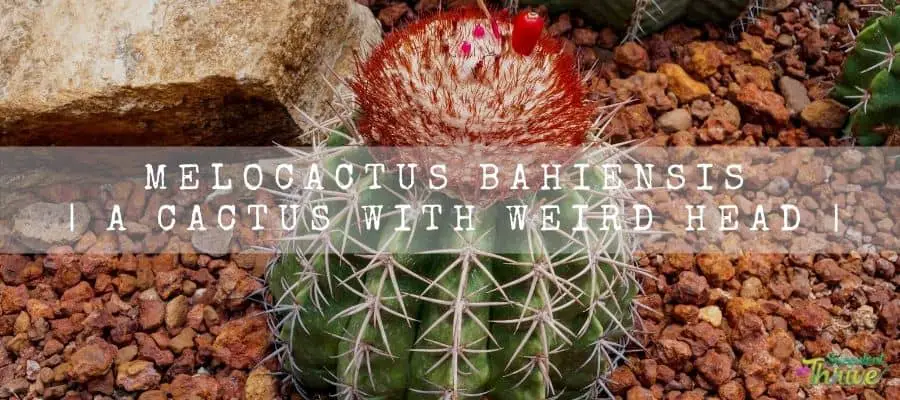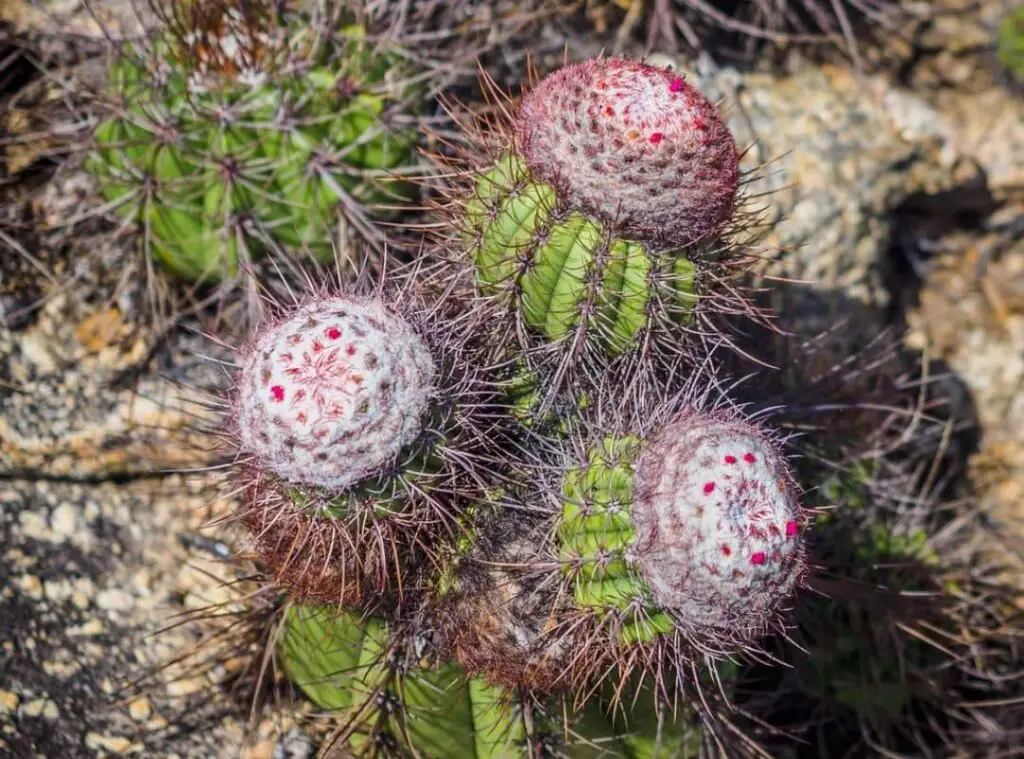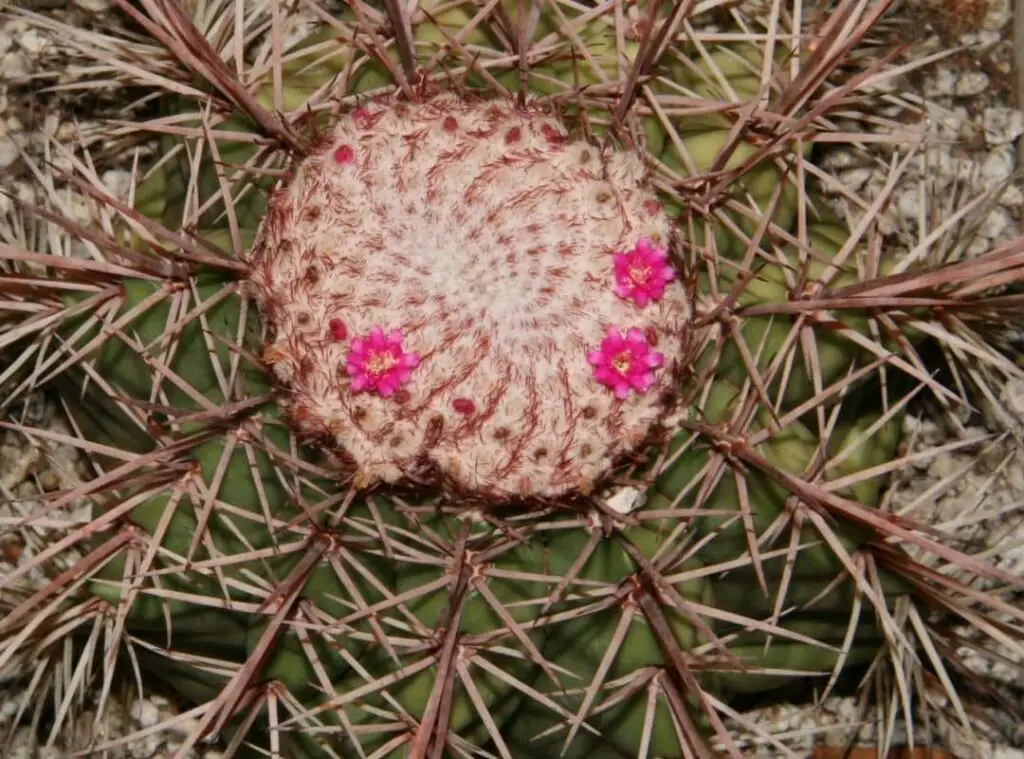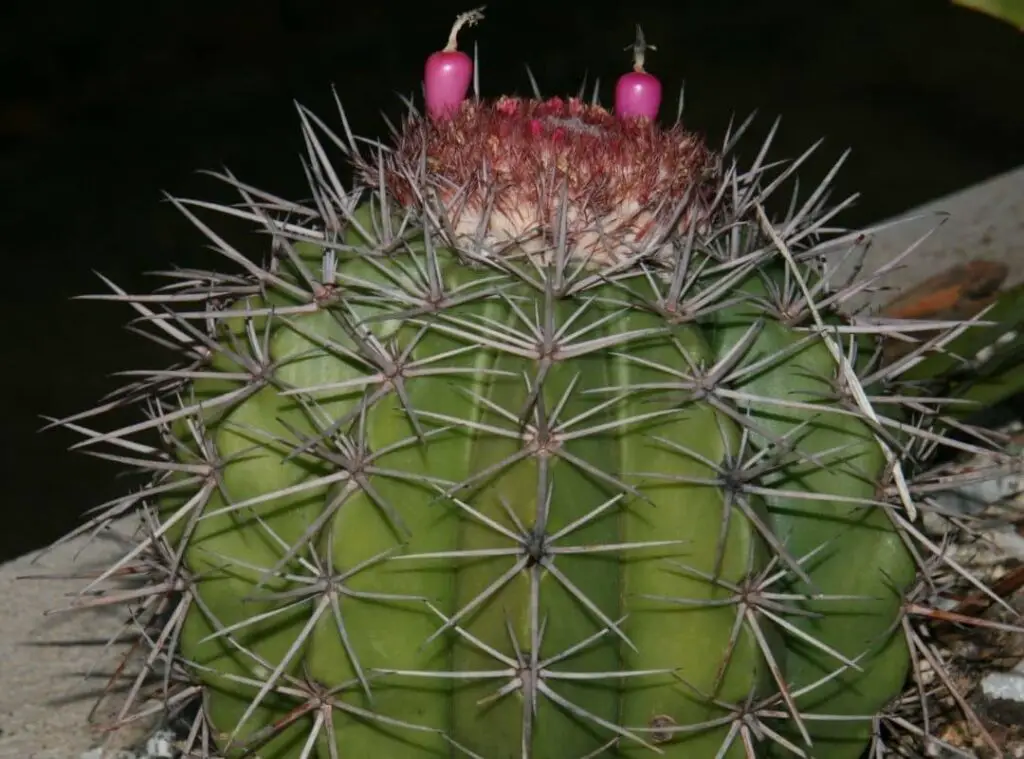Melocactus bahiensis are native plants to Brazil. Their natural habitats would be around the vegetation in sandy soil around the rocks.
You could commonly spot the them along with the Pilosocereus floccosus. Melocactus bahiensis are a spectacular set of plants which anybody would want to have. They are attractive in their looks.
They belong to the family cactaceae and to the genus Melocactus. However, looking after them is somewhat challenging.
Hence, I do not recommend this as a plant for the freshers in gardening. Having said that, if you are a keen succulent gardener who wishes to find out more about these precious plants, you may find this article fruitful.

How do I identify Melocactus bahiensis?
Melocactus bahiensis cactus are tiny plants which consist of ribbed stems. They would further consist of a cephalium.
The cephalium would be full of wool and with bristles. Those bristles would be brown in color. The stem color would be light to dark green.
The stem shape would be more like a globose shape. Moreover, they would usually be about 8 inches ( 20 cm ) in width.
Melocactus bahiensis cactus cephalium would be about 2 inches ( 5 cm ) in height and 3 inches ( 7.5 cm ) in width. Besides, they would carry spines which are short and curved.
Those spines would be off white in color. There will be about 1- central spines and 7-12 radial spines.
However, the new ones would be yellow, red brown and dark brown to black colored. In addition to these factors, Melocactus bahiensis cactus produce flowers in pink.
They would be 1 inch ( 2,5 cm ) in length. Besides, they would carry a diameter of 0.5 inches ( 1.3 cm). Last but not least, Melocactus bahiensis cactus fruit’s top part would tend to take a red to crimson color.
On the other hand, the bottom part of the fruits would tend to take a pale pink to white color. Moreover they would be 1 inch ( 2.5 cm ) in length and 0.4 inches ( 1 cm ) in width.
The Melocactus bahiensis cactus fruit would be more club-shaped. They consist of tuberculate seeds too.
Growth rate
Melocactus bahiensis cactus are a relatively fast-growing set of plants if you grow them under best conditions.
One look care guide
| Botanical Name | Melocactus bahiensis |
| Common Name | Turk’s cap cactus |
| Plant Type | Cactus |
| Mature Size | 8 inches ( 20 cm ) in diameter |
| Sun Exposure | Full sunlight to partial shade |
| Soil Type | Well draining and sandy soil mix |
| Soil pH | Ph. of 6 |
| Flower Color | Pink |
| Hardiness Zones | USDA hardiness zone 10a to 11bfrom 30 °F (−1.1 °C) to 30 °F (−1.1 °C) |
| Native Area | Brazil |
| Toxicity | Non toxic |
| Average price | 12 USD |
How do you take care of Melocactus bahiensis?
Light Requirement
It is important that you fulfill the plant’s sunlight requirement as it will be a crucial factor when it comes to looking after them well.
Literally they would require bright sunlight but, in less quantities, when compared to the rest of other cacti which grow in arid conditions.
When you expose them to strong sunlight, it would make them turn into bronze. Consequently, it will help the plants to produce attractive flowers. Moreover, it will encourage the plants to produce firm spines too.
Temperature and humidity
Melocactus bahiensis cactus do not tolerate cold weather at all. Literally they are not the types of plants which tolerate even the fairly cool temperatures as well.
Hence, keep in mind that you always need to expose them to a temperature range of 8-12 degrees Celsius.

Is it cold hardy?
Melocactus bahiensis cactus do not tolerate colder weather conditions and they are not cold hardy plants.
USDA Hardiness Zone
Melocactus bahiensis cactus will thrive well if you live in USDA hardiness zone 10a to 11b: from 30 °F (−1.1 °C) to 30 °F (−1.1 °C).
Watering Requirement
Do not make the Melocactus bahiensis cactus deprived of water for too long as simply they cannot stand it.
On the other hand, too much water will also lead to rot. Melocactus bahiensis cactus roots cannot absorb water from wet soil.
Ideally water them moderately and allow the soil to wither in between two watering sessions.
Soil Requirement Type / pH
Consider growing the Melocactus bahiensis cactus in a porous standard cactus soil mix as they would be beneficial for the healthy growth and for the wellbeing of the plants.
If you end up using a wrong soil mix which would hold onto excess water instead of moving them out, chances are that your precious Melocactus bahiensis might suffer from root rot.
Pot size Potting and Repotting
You need to select a porous pot to grow the Melocactus bahiensis cactus. Additionally, make sure it has one draining hole too. When it comes to reporting, I recommend doing it once every two years.
Where to Plant
You need to plant them somewhere where the Melocactus bahiensis cactus can gain adequate sunlight. Moreover, choose a pot which has good drainage also.
Fertilizer and time of year
Consider using a fertilizer which is specifically designed for cactus to feed them. Further apply those fertilizers during their active growing season and refrain from feeding them in winter.
Flower
Melocactus bahiensis cactus bloom with pink flowers.

Dormancy
Toxicity
These cacti are not toxic to humans or pets.
Common bugs and illnesses
Melocactus bahiensis cactus are vulnerable to some of the insects as well as to some diseases. However, if you look after them well, it is very unlikely that you will have to go through these conditions.
If you have grown them in a right soil mix which has an excellent drainage and a good aeration, your precious Melocactus bahiensis cactus would grow pest free. However, pests such as red spiders, mealy bugs, scales would be troublesome for them.
In addition to these, Melocactus bahiensis cactus may suffer from rot, given that you provide water in excess for them.
Moreover, if you had grown them in a poor draining soil mix, it would also cause rot. Root rot could be so dangerous as if it’s spread on a severe level, you will not be able to revive the plants despite what you do. Literally, the fungicides would also not be effective in this.

How to propagate Melocactus bahiensis
You can propagate the Melocactus bahiensis cactus by using the seeds. To do that, you need to ideally sow them in a light sandy soil porous soil mix.
Keep in mind to cover the germination tray with glass so that it will avoid the seeds from drying out. A temperature range of 18-22 degrees Celsius would suit here the best.
Conclusion
To sum up what we covered here, Melocactus bahiensis cactus are such a versatile set of plants to have and they will flourish if you look after them well.
Be mindful of the facts we had mentioned in the article and try growing these beautiful plants and you will not be disappointed.
Read Next : Melocactus Intortus | A Cactus With A Weird Head | Melocactus Curvispinus | Cactus With A Weird Head | Melocactus Matanzanus | Cactus With A Weird Head |
